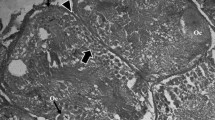Abstract
A comparative study of the use of yolk reserves during post-embryonic development was performed on three teleostean fishes of aquacultural interest: the sea bream Sparus aurata, the sea bass Dicentrarchus labrax, and the pike-perch Stizostedion lucioperca. The first part of the work was devoted to the structural development of the periblast, the vitellus and the oil globule during the endotrophic and endo-exotrophic phases of larval life. Observations using transmission electron microscopy revealed a perivitelline circulation system closely related to the liver, and suggested an important function of the periblast in the utilization of reserves. In the second part of the study, cytochemical reactions revealed the way in which the reserves are resorbed. Glycogen contained in the periblast at hatching was utilized during the endotrophic period. The successive appearance of lipoprotein particles in the periblast endoplasmic reticulum, Golgi apparatus, and perivetelline circulation zone is consistent with the mobilization of yolk and oil globule components. Comparison of fed and fasting individuals revealed that fasting tended to slow down rather than increase the utilization of reserves.
Similar content being viewed by others
References
Aronovich TM, Dorosher SJ, Spectorova LV, Makhotin VM (1975) Egg incubation and larval rearing of navaga (Eleginus navaga Pall.), polar cod (Boreogadus saida Lepechin) and artic flounder (Liopsetta glacialis Pall.) in the laboratory. Aquaculture, Amsterdam 6: 233–242
Balon EK (1977) Early ontogeny of Labeotrophus Ahl, 1927 (Mbuna, Cichlidae, Lake Malawi), with a discussion on advanced protective styles in fish reproduction and development. Envir Biol Fish 2: 147–176
Barnabé G (1976) Contribution à la connaissance du loup Dicentrarchus labrax (L.) (poissons Serranidae). Thèse Doctorat Etat. Montpellier
Boulekbache H (1981) Energy metabolism in fish development. Am Zool 21: 377–389
Burd LI, Jones MD Jr, Simmons MA, Makowski EK, Meschia G, Battaglia FC (1975) Placental production and foetal utilisation of lactate and pyruvate. Nature, Lond 254: 710–711
Deplano M, Connes R, Diaz JP, Barnabé G (1991) Variation in the absorption of macromolecular proteins in larvae of the sea bass Dicentrarchus labrax during transition to the exotrophic phase. Mar Biol 110: 29–36
Diaz JP, Guyot E, Vigier S, Connes R (1996) First occurrence of intestinal lipid absorption during post-embryonic development of the sea bream Sparus aurata. J Fish Biol (in press)
Eisler R (1957) Some effects of artificial light on salmon eggs and larvae. Trans Am Fish Soc 87: 151–162
Eldridge MB, Whipple IA, Eng D (1981a) Endogenous energy sources as factors affecting mortality and development in striped bass (Morone saxatilis) eggs and larvae. Rapp P.-v. Réun Cons perm int Explor Mer 178: 568–570
Eldridge MB, Whipple IA, Eng D, Bowers MJ, Jarvis BM (1981b) Effects of food and feeding factors on laboratory-reared striped bass larvae. Trans Am Fish Soc 110: 111–120
Gossrau R, Graff R (1986) Comparative hydrolase cytochemistry of the native guinea-pig and marmoset yolk sac with special reference to proteases. Acta histochem 80: 135–147
Hamai I, Kyûshin K, Kinoshita T (1974) On the early larval growth, survival and variation of body form in the walleye pollock. Theragra chalcogramma (Pallas), in rearing experiments feeding the different diets. Bull Fac Fish Hokkaido Univ 25: 20–35
Mani-Ponset L, Diaz JP, Schlumberger O, Connes R (1994) Development of yolk complex, liver and anterior intestine in pike-perch larvae, Stizostedion lucioperca (Percidae), according to the first diet during rearing. Aquat living Resour (Nantes) 7: 191–202
Miki A, Kugler P (1984) Comparative enzyme histochemical study on the visceral yolk sac endoderm in the rat in vivo and in vitro. Histochemistry 81: 409–415
Plonné D, Winkler L, Franke H, Dargel R (1992) The visceral yolk sac: an important site of synthesis and secretion of apolipoprotein β containing lipoproteins in the feto-placental unit of the rat. Biochim biophys Acta 1127: 174–185
Rogers BA, Westin DT (1981) Laboratory studies on effects of temperature and delayed initial feeding on development of striped bass larvae. Trans Am Fish Soc 110: 100–110
Seligman AM, Wasserkrug HL, Hanker JS (1966) A new staining method (OTO) for enhancing contrast of lipid-containing membranes and droplets in osmium tertroxide-fixed tissue with osmiophilic thiocarbohydrazide (TCH) J Cell Biol 30: 424–432
Shimizu M, Yamada J (1980) Ultrastructural aspects of yolk absorption in the vitelline syncytium of the embryonic rockfish, Sebastes schlegel. Jap J Ichthyol 27: 56–63
Singh J (1964) A modification of the Masson-Hamperl method for staining of argentaffin cells. Anat Anz 115: 81–82
Terner C (1968) Studies of metabolism in embryonic development. III. Glycogenolysis and glycogenogenesis in trout embryos. Comp Biochem Physiol 25: 989–1003
Thiéry JP (1967) Mise en évidence de polysaccharides sur coupes fines en microsecopie électronique. J Microscopie 6: 987–1017
Vernier JM (1969) Table chronologique du développement embryonnaire de la truite arc-en-ciel, Salmo gairdneri Rich. Annls Embryol Morphogén 2: 495–520
Vernier JM, Sire MF (1977a) Lipoprotéines de très basse densité et glycogène dans le syncytium vitellin, l'épithélium intestinal et le foie, aux stades précoces du développement embryonnaire chez la truite arc-en-ciel. Biol cell 29: 45–54
Vernier JM, Sire MF (1977b) Plaquettes vitellines et activité hydrolasique acide au cours du développement embryonnaire de la truite arc-en-ciel. Etude ultrastructurale et biochimique. Biol cell 29: 99–112
Walzer C, Schönenberger N (1979a) Ultrastructure and cytochemistry study of the yolk syncytial layer in the alevin of trout (Salmo fario trutta L.) after hatching. I. The vitellolysis zone. Cell Tissue Res 196: 59–73
Walzer C, Schönenberger N (1979b) Ultrastructure and cytochemistry of the yolk syncytial layer in the alevin of trout (Salmo fario trutta L. and Salmo gairdneri L.) after hatching. II. The cytoplasmic zone. Cell Tissue Res 196: 75–93
Wille KH (1988) Über das Glykogen im fetalen Darmepithel. Anat Anz 167: 129–139
Author information
Authors and Affiliations
Additional information
Communicated by A. Rodríguez, Puerto Real
Rights and permissions
About this article
Cite this article
Mani-Ponset, L., Guyot, E., Diaz, J.P. et al. Utilization of yolk reserves during post-embryonic development in three teleostean species: the sea bream Sparus aurata, the sea bass Dicentrarchus labrax, and the pike-perch Stizostedion lucioperca . Marine Biology 126, 539–547 (1996). https://doi.org/10.1007/BF00354636
Received:
Accepted:
Issue Date:
DOI: https://doi.org/10.1007/BF00354636



